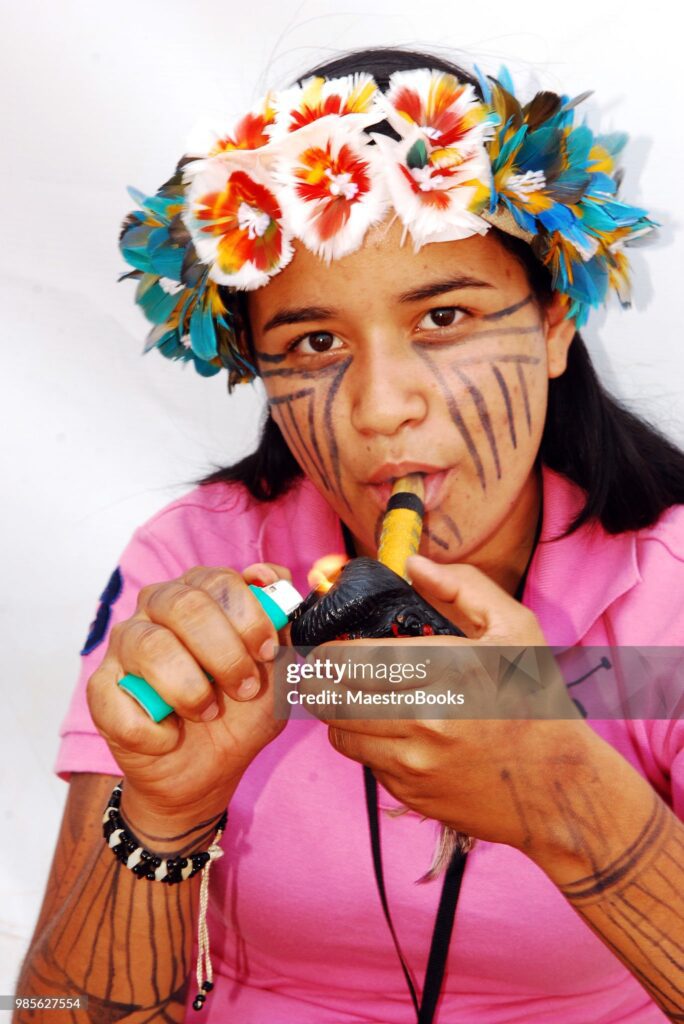By Fabiana Maizza
For the Jarawara, an Indigenous people of Brazil’s Juruá and Purus river region, snuff – known as sinã – is more than a daily habit. It is a substance deeply tied to thought, care, and meaning. And it belongs, above all, to women. Jarawara women are the primary makers, users, and connoisseurs of sinã, treating it as a cherished part of village life – a small treasure woven into the rhythms of everyday existence.

To describe – or perhaps translate – the world in which the Jarawara live, one must begin with a set of core actions: taking (towaka), going (toka), returning (kama), seeking (waka), bringing (kaki), carrying (weye), catching (wata), and holding (tama). As in many other Amerindian societies, these verbs of movement express foundational concepts in a system of action that structures the tempo and texture of daily life.
Nearly everything in Jarawara life is carried – or more precisely, must be carried from one place to another. Objects, by virtue of being objects, seem to demand movement. Plants are first cultivated near the houses, then transplanted to gardens. Staple crops, such as manioc, cassava, yams, and bananas, are transported back to homes for consumption. Game (bani) and fish, once caught, are brought to the village to be prepared. Children are carried in slings, firewood is hauled from the forest, and cassava flour, once processed in ovens, is returned to the home.
The volume of things carried is so extensive that it defies exhaustive listing, but a few examples suggest the scale: engines, boats, generators, gas cylinders, stoves, party keyboards, firewood, clay, and countless others. Daily life is woven through the ceaseless circulation of objects.
Underlying the verbs of going, returning, taking, and carrying is another existential concept: nofa – to want, to desire, to like. Among many Amerindian groups, the notion of will is central. One must possess the will to act, and collective tasks – such as producing cassava flour, which requires multiple participants – depend on the ability to transmit that will to others, to persuade, entice, or awaken in them a shared desire to act.
Snuff appears to mediate both the realm of movement – taking, going, coming, being taken, and being carried – and the realm of affect: desire, pleasure, and inclination. It is associated with a state I term wandering, functioning perhaps as a conductor – a conduit of will. Within this framework, snuff activates a form of takeable agency, a disposition to be moved or carried. Given that Jarawara women are the primary consumers of tobacco, they are especially attuned to its conductive effects. This receptivity – to be takeable (towakama), carryable (weyena)-constitutes what I call takeable agency.
Jarawara women’s takeable agency (towakama) appears analogous to the shaman’s knowledge and his intricate networks of cosmopolitical relations. Like other Indigenous shamans, the Jarawara inawa are tasked with cultivating and maintaining relationships with nonhuman beings—a demanding and relationally intensive practice.
Among the Jarawara, shamanic practice is invariably mediated by the use of snuff. The inawa must first inhale sinã in order to summon his “auxiliary spirits” – the souls of cultivated plants, or plant-children, such as peach palm, tingui, banana, and tobacco. Once invoked, these spirits come to communicate with the shaman and may also transport him – carrying him on their backs (weye) – to distant realms where he forges relationships and alliances with other beings. Apart from women, only shamans are involved in the preparation of sinã.
It may be productive to consider a conceptual proximity between women and shamans, linked through their shared relation to snuff and a particular form of takeable agency—what might be termed a female shamanic agency or a shamanic female agency. This agency could enable them to be carried by sinã, with snuff functioning as a mediator of communication and movement. In this sense, sinã facilitates the circulation not only of physical bodies but also of thoughts and words, extracting from individuals the will that renders them takeable.
However, this should not be taken to associate the use of snuff by women and shamans with the “transcendental.” Reducing the practice to a binary of sacred versus profane overlooks its fundamentally immanent and quotidian nature. Inhaling sinã is a profoundly ordinary act – performed in the morning after meals, during afternoon visits, before bathing, and especially before sleep.
The Jarawara consume snuff throughout the day, often so routinely that it may go unnoticed. People take sinã when they feel the will, when in company, or both. Above all, snuff occupies a central place in thought and affect; it is the source of courage (oko badyi), the will that enables individuals to embrace and enjoy the moment.
The close relationship between women and tobacco plants invites us to consider their coevolution, suggesting that women’s care for the plants and the plants’ care for women are mutually constitutive—that is, women and tobacco are co-constitutive. As noted, the concept of transcendence offers limited insight into these relations. A more productive approach may be to reconsider care itself, framing it within the politics of everyday life.
The care women invest in gardens, tobacco plants, sinã, people, and animal husbandry forms a network of relationships extending to diverse beings and the forest as a whole. This dynamic can be characterized as a “female politics of life,” where care is central to action and world-making. Within this framework, the notion of “takeable agency” reveals that the capacity to be taken is embedded in complex relations of care – aligning more closely with political agency than with any notion of passive domesticity.
EDITOR’S NOTE: Fabiana Maizza is an assistant professor of anthropology at the Federal University of São Paulo (Unifesp), Brazil. Her current research focuses on the relations between humans and cultivated plants, as well as on gender relations among the Jarawara. She has published articles on female agency, feminist politics of life, ecology and feminism, and human-plant relations. She is an associate researcher at the Centre of Amerindian Studies (CESTA) at the University of São Paulo and a member of the Société des Américanistes (Musée du Quai Branly), Paris.
This is an adapted excerpt from Women and Psychedelics: Uncovering Invisible Voices, © 2024 the Chacruna Institute, edited by Erika Dyck, Patrick Farrell, Beatriz Caiuby Labate, Clancy Cavnar, Ibrahim Gabriell, and Glauber Loures de Assis. It is licensed under the Creative Commons Attribution-NonCommercial-ShareAlike 4.0 International License (CC BY-NC-SA 4.0) by permission of Synergetic Press. This piece was translated from Portuguese by John Milton. Earth | Food | Life, a project of the Independent Media Institute, adapted and produced this excerpt for the web.




